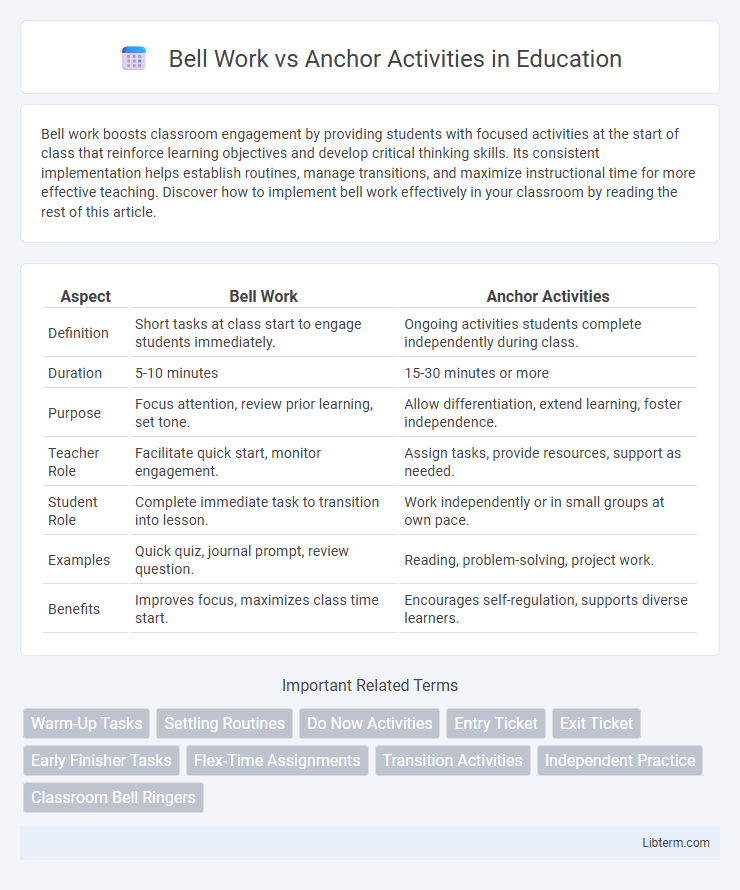Bell work boosts classroom engagement by providing students with focused activities at the start of class that reinforce learning objectives and develop critical thinking skills. Its consistent implementation helps establish routines, manage transitions, and maximize instructional time for more effective teaching. Discover how to implement bell work effectively in your classroom by reading the rest of this article.
Table of Comparison
| Aspect | Bell Work | Anchor Activities |
|---|---|---|
| Definition | Short tasks at class start to engage students immediately. | Ongoing activities students complete independently during class. |
| Duration | 5-10 minutes | 15-30 minutes or more |
| Purpose | Focus attention, review prior learning, set tone. | Allow differentiation, extend learning, foster independence. |
| Teacher Role | Facilitate quick start, monitor engagement. | Assign tasks, provide resources, support as needed. |
| Student Role | Complete immediate task to transition into lesson. | Work independently or in small groups at own pace. |
| Examples | Quick quiz, journal prompt, review question. | Reading, problem-solving, project work. |
| Benefits | Improves focus, maximizes class time start. | Encourages self-regulation, supports diverse learners. |
Understanding Bell Work: Definition and Purpose
Bell Work consists of short, focused tasks assigned at the start of a class to engage students immediately and set the learning tone. Its primary purpose is to activate prior knowledge and transition students into the lesson, enhancing classroom management and productivity. This strategy supports continuous student engagement and reinforces daily learning objectives effectively.
What Are Anchor Activities?
Anchor activities are purposeful tasks designed to engage students independently while the teacher works with small groups or individual learners. These activities support differentiated instruction by providing meaningful practice, reinforcing skills, or extending learning without direct teacher supervision. Common anchor activities include reading assignments, math problem-solving, or interactive projects that align with curriculum goals.
Key Differences Between Bell Work and Anchor Activities
Bell Work consists of short, focused tasks students complete at the start of class to engage and transition into learning, typically lasting 5-10 minutes. Anchor Activities are longer, independent assignments designed to keep students productively occupied when the teacher is unavailable, supporting differentiated pacing and sustained learning. Key differences include the duration, purpose--immediate engagement versus ongoing independent work--and timing within the lesson structure.
Benefits of Implementing Bell Work in the Classroom
Bell work enhances classroom management by providing students with structured tasks immediately upon arrival, increasing focus and reducing downtime. This strategy promotes consistent engagement, allowing teachers to assess prior knowledge and tailor instruction effectively. Implementing bell work cultivates a productive learning environment that supports time efficiency and reinforces essential skills daily.
Advantages of Using Anchor Activities for Student Engagement
Anchor activities provide continuous learning opportunities that keep students engaged during transitional periods, reducing downtime and off-task behavior. These activities foster independence and self-regulation by allowing students to choose tasks aligned with their interests and skill levels, promoting deeper cognitive engagement. Implementing anchor activities also supports differentiated instruction, enabling teachers to address diverse learning needs efficiently within a busy classroom environment.
When to Use Bell Work vs. Anchor Activities
Bell Work is most effective at the beginning of a class to quickly engage students and review previous material or introduce a new topic, maximizing initial instructional time. Anchor Activities are best used during independent work periods or when the teacher needs time to provide targeted support, offering meaningful tasks that keep students productively occupied. Choosing between Bell Work and Anchor Activities depends on the timing within the lesson and the desired level of student independence and engagement.
Strategies for Effective Bell Work Implementation
Effective bell work strategies include providing clear, concise instructions that students can follow independently within the first few minutes of class. Utilizing varied, engaging tasks tied to learning objectives helps maintain student focus and transition smoothly into the main lesson. Incorporating quick assessments or reflection prompts encourages active participation and reinforces prior knowledge.
Creative Ideas for Anchor Activities Across Subjects
Anchor activities foster student engagement by providing ongoing tasks that reinforce learning across subjects, such as journal prompts in language arts, math puzzles that stimulate problem-solving, or science observation logs that encourage inquiry. Creative anchor activities include collaborative storytelling in social studies to enhance cultural understanding, art-based projects linked to historical events, and inquiry-based experiments in science that can be extended over several class periods. Integrating technology through interactive simulations or digital portfolios allows students to deepen subject comprehension while facilitating personalized learning pathways.
Addressing Common Challenges with Bell Work and Anchor Activities
Bell Work and Anchor Activities help address common classroom management challenges by providing structured tasks that engage students immediately, minimizing downtime and disruptions. Bell Work focuses on quick, focused tasks that activate prior knowledge and set a purposeful tone for the lesson, while Anchor Activities offer ongoing assignments that students can independently complete, supporting differentiated pacing and reducing off-task behavior. Both strategies enhance student accountability and promote a productive learning environment through clear expectations and consistent routines.
Choosing the Right Approach for Your Students
Selecting between Bell Work and Anchor Activities depends on your students' learning needs and classroom dynamics. Bell Work offers short, focused tasks that help students transition and activate prior knowledge at the start of class. Anchor Activities provide extended, independent learning opportunities that support differentiated pacing and foster deeper engagement for students who finish early or need enrichment.
Bell Work Infographic

 libterm.com
libterm.com